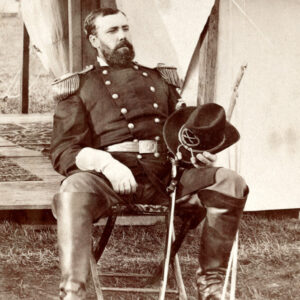calsfoundation@cals.org
Expedition from Brownsville to Fairview (November 28–December 9, 1864)
The November 28–December 9, 1864, scouting expedition from Brownsville (Lonoke County) to Fairview (White County) was mainly conducted to clear guerrillas from north-central Arkansas and to requisition livestock for use by Union forces.
Brigadier General Eugene A. Carr issued explicit orders for a scouting expedition on November 24, 1864, calling for 500 Union cavalrymen to clear “out the rebels and guerrillas northeast of Searcy and between Little Red and White Rivers.” The scouts were to seize “all good beeves” they could find and send them to Little Rock (Pulaski County), giving the owners receipts they would use to get paid “unless…notorious rebels.” Carr stressed that the Federals should conduct themselves responsibly and that the commander should “inflict summary punishment on all marauders” among his troops.
Carr added that “certain citizens of the neighborhood” of the scouting expedition “wish to go with the scout and make themselves useful as guides,” including Unionist senator Enoch Dean Rushing of Rock Point (Independence County); in addition, the scouts would escort Rushing’s wife, Mary Ann Rushing, to her home at Salado (Independence County).
Twelve officers and 500 enlisted men of the Tenth Illinois Cavalry Regiment left Brownsville on the morning of November 28, 1864, under Major Joseph S. McCartney to conduct the raid. They reached Cook’s Mills on Des Arc Bayou at noon the next day, and McCartney sent a patrol from there to Searcy (White County) and West Point (White County).
The Illinoisans crossed the Little Red River at Hilcher’s Ferry on November 30 and followed the river to Big Creek. From there, McCartney sent four patrols out to look for Confederate soldiers rumored to be in the area. The next day, he moved the remainder of the expedition to Richards’ Mills to await the patrols; they all returned that night with prisoners “all claiming to be deserters.” The patrols also found few cattle and little forage in the region.
From there, the Tenth Illinois men proceeded to Independence County’s Greenbrier Township, where patrols roamed the area outside of Batesville (Independence County), “none of them hearing of any organized party of rebels.” Because of a lack of forage, McCartney moved his troops toward Fairview, where he received a message from Carr “telling me to return if I could not subsist my command.” McCartney said, “I found I could not do so and returned,” reaching Brownsville by December 9, 1864.
McCartney reported capturing fourteen Confederates, “including 2 lieutenants and 3 surgeons,” and bringing in thirty-four cows, seventeen mules, and forty-five horses; he provided receipts to the owners for all. The major added: “I would further report that the citizens sent as guides are, as a general thing, not to be depended on.”
The scout from Brownsville to Fairview is typical of many such expeditions in which Federal bases in Arkansas sent patrols out to hunt for Confederate soldiers and guerrillas, as well as livestock and supplies of forage to feed them.
For additional information:
The War of the Rebellion: A Compilation of the Official Records of the Union and Confederate Armies, Series I, Vol. 41, part 1, pp. 900–901; part 4, p. 668. Washington, DC: Government Printing Office, 1893.
Mark K. Christ
Central Arkansas Library System
 Civil War Timeline
Civil War Timeline Military
Military Eugene Asa Carr
Eugene Asa Carr 




Comments
No comments on this entry yet.